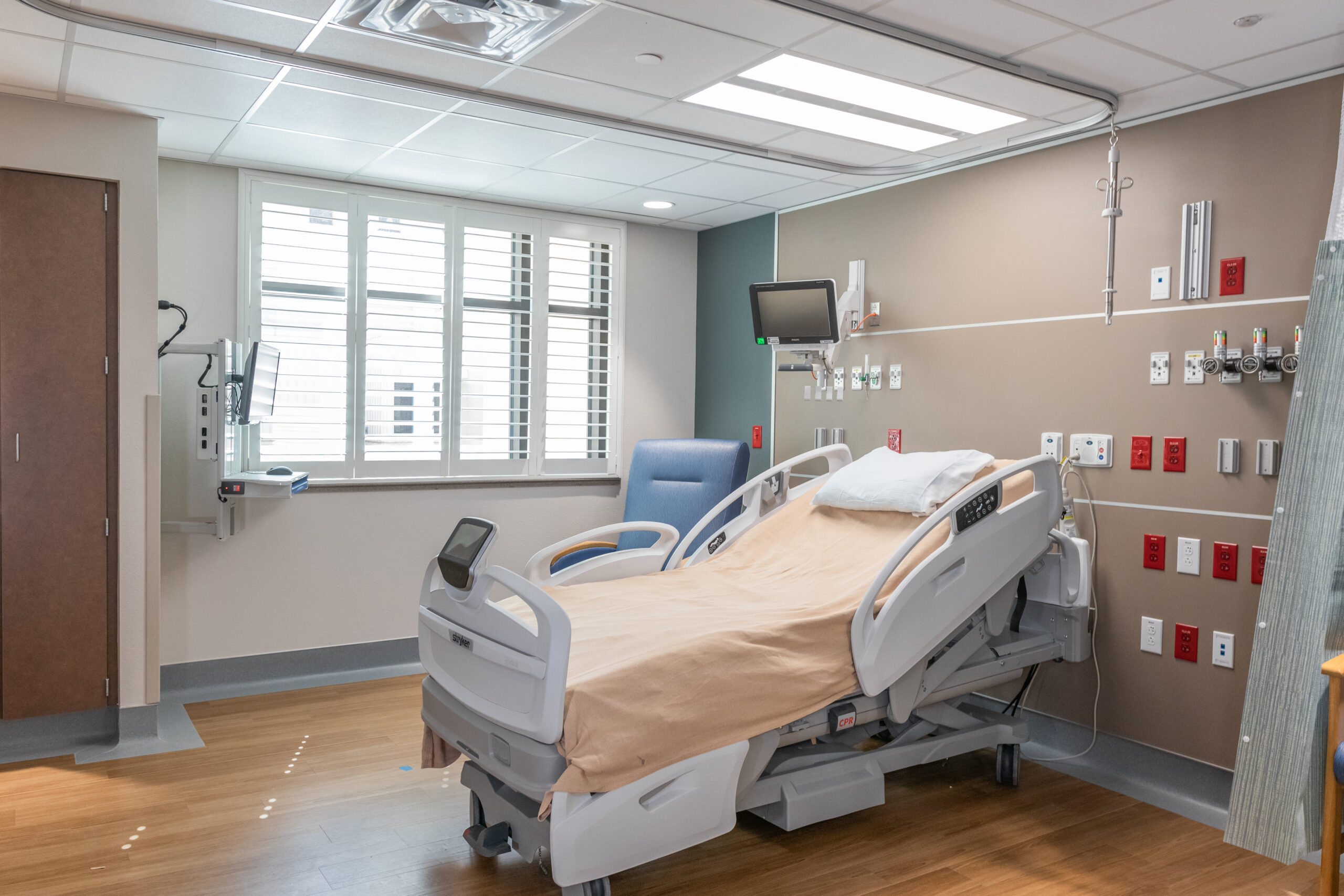Understanding Urban vs. Rural Healthcare Needs in Architectural and Engineering Design
Healthcare facilities are critical to the well-being of communities, and their design must respond to the unique needs of the populations they serve. As architects and engineers, we play a pivotal role in this process to create facilities that provide effective patient care, operational efficiency and ongoing contributions to community well-being. Our long-term relationships with healthcare systems throughout the state of Texas have allowed us to develop a thorough understanding of the differing needs of urban and rural healthcare clients and their projects.
Site Location and Accessibility
Urban healthcare facilities are typically located in densely populated areas, necessitating designs that maximize accessibility. Multi-story buildings with elevators and expansive waiting areas cater to high patient volumes and diverse populations. Proximity to public transportation is essential, enabling easy access for patients and staff. Parking spaces are limited, and thus, facilities often utilize underground parking or nearby lots.
In contrast, rural healthcare facilities often occupy larger parcels of land and are strategically located to serve larger geographic areas. Planning for transportation and access often results in facilities that are situated near major thoroughfares because public transportation options may be more limited, if they exist at all. The layout typically prioritizes clear sightlines and ease of navigation, often featuring separate entrances for different services. These facilities may also include expansive outdoor areas for community engagement and wellness programs.
Cultural Context and Community Engagement
The cultural fabric of urban and rural areas can differ significantly, influencing patient interactions and community health initiatives. As designers we are continuously sensitive to these cultural nuances to ensure our projects encourage community engagement, promote trust, and enhance the patient experience.
Most urban healthcare facilities tend to reflect contemporary architectural trends, incorporating sleek designs and glass facades that signify modernity and innovation. Artwork and cultural representations that resonate with a diverse urban population are frequently integrated into the design to enhance the healing environment.
Rural healthcare designs may embrace a more traditional aesthetic that resonates with local culture and history. Our team’s process includes developing a deep understanding of the community and aligning materials and architectural styles that reflect regional characteristics, creating a sense of familiarity and comfort for patients. Natural elements, such as gardens and local artwork, are commonly incorporated to foster a welcoming atmosphere and provide places for community gatherings.
Range of Services Offered
Urban areas have higher population densities, leading to different healthcare demands compared to rural regions, where populations are often dispersed. Many specialized services are typically necessary, including emergency care, surgical units and outpatient clinics. Urban facilities may also face challenges related to high patient volumes, requiring designs that facilitate efficient patient flow. Designs for these facilities allow for distinct zones that streamline operations and accommodate high patient turnover.
Rural facilities may accommodate fewer patients, but must also ensure that a diverse array of services is accessible to a larger geographical area. These facilities often include a wide range of services—from preventative care to primary care and urgent care, while including additional services such as maternity care, emergency services, surgical suites, and mental health support—within a single location, aiming to provide comprehensive care for the community. These projects are designed with multi-functional, flexible spaces that can adapt to various healthcare needs. For instance, examination rooms can be designed to serve both urgent care and wellness visits. Thoughtful architectural designs allow for the integration of various healthcare services—such as outpatient, inpatient, urgent care, and specialty services—within a single location.
Patient Experience
In rural settings, patient and staff experience focuses on community and continuity of care. Designs often include private consultation rooms that foster patient-provider relationships. Spaces for family involvement and community health education can also enhance the overall patient experience.
The higher volume of patients in urban hospitals requires designs that focus on efficient patient flow and comfort. Waiting areas are often large and designed to reduce stress, featuring amenities such as cafes and child-friendly zones. The need for staff collaboration is emphasized, with shared workspaces and break areas that facilitate communication and teamwork.
Staff Recruitment and Retention
Attracting healthcare practitioners can be less difficult in urban areas due to their location, amenities, and professional development opportunities. The availability of specialized training and a wide network of colleagues can enhance job satisfaction and retention rates.
Recruiting and retaining healthcare providers in rural areas can be much more challenging. To address this, rural facilities may incorporate designs that include staff accommodations and community spaces to foster a supportive work environment. By providing living quarters or nearby housing options, rural hospitals can encourage longer-term commitments from healthcare professionals. Design considerations may include staff housing, community engagement areas, and amenities that promote a healthy work-life balance. Staff areas may be designed to accommodate overnight stays, as rural healthcare providers often cover on-call duties that extend beyond regular hours. Additionally, integrated spaces designed for professional development and collaboration can enhance job satisfaction and retention rates among staff.
Technology Integration
In urban areas, advanced medical technology and telemedicine capabilities are critical due to the complexity of services offered. Urban healthcare facilities often benefit from advanced infrastructure, including robust utilities and high-speed internet access. This supports the integration of telemedicine and electronic health records, which are increasingly vital in providing timely care. The design must accommodate advanced medical equipment and technology, requiring careful planning for electrical loads, specialty plumbing, and high performing HVAC systems.
While technology is also important in rural settings, the focus may be on creating adaptable spaces for telemedicine and community health initiatives. As a result, the design often emphasizes resilience and sustainability, incorporating renewable energy sources, such as solar panels, and water-efficient systems. Telemedicine is increasingly important in rural areas, prompting designs that include dedicated spaces for virtual consultations with remote specialists.
Sustainability and Resource Allocation
Urban healthcare facilities generally have access to greater resources, including funding, technology, and specialized personnel. Urban facilities often incorporate sustainable practices due to stricter regulations and a focus on reducing environmental impact. This includes energy-efficient systems and green building materials.
In contrast, rural healthcare systems often operate with limited budgets and staff. Design for rural healthcare facilities can emphasize resilience, using local materials and sustainable practices to withstand natural events and ensure long-term viability. Another challenge may be the limited suppliers who can deliver, service, or maintain their building systems and equipment in the area. Understanding these disparities allows our team of architects and engineers to design facilities that are not only resource-efficient but also prioritize the essential services needed in rural settings.
Regulatory Considerations and Funding
Urban healthcare facilities must navigate a complex landscape of zoning laws, building codes, and regulatory requirements. Compliance with these regulations is often more demanding, requiring detailed planning and considerable investment. With experience working on dozens of urban healthcare projects, our architects have developed a deep understanding of these variations to ensure compliance and to design facilities that can maximize efficiency and align with available budgets.
Although rural facilities may encounter less stringent regulatory environments, they often face challenges related to funding and resource allocation. Grants specifically aimed at improving rural healthcare infrastructure can play a significant role in supporting construction and renovation projects. Design efforts in these settings are often community-driven, reflecting local needs and priorities.
Conclusion
As architects and engineers, our understanding of the differences between urban and rural healthcare needs is not just beneficial; it is essential for creating effective healthcare facilities that are responsive to their individual needs. By addressing key considerations such as site selection, service offerings, technology integration, staff retention, patient experience, and sustainability, our design team can ensure that healthcare projects meet the unique challenges of their environments. Ultimately, thoughtful and informed design can lead to improved health outcomes, greater community engagement, and enhanced overall well-being for patients in both urban and rural settings.


